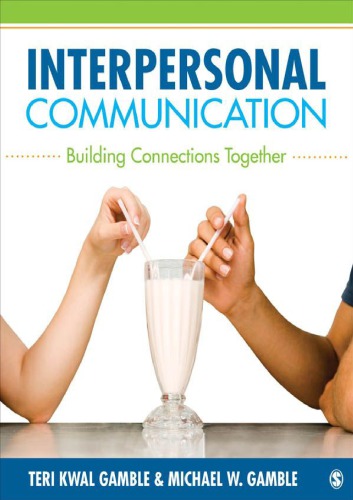

Most ebook files are in PDF format, so you can easily read them using various software such as Foxit Reader or directly on the Google Chrome browser.
Some ebook files are released by publishers in other formats such as .awz, .mobi, .epub, .fb2, etc. You may need to install specific software to read these formats on mobile/PC, such as Calibre.
Please read the tutorial at this link. https://ebooknice.com/page/post?id=faq
We offer FREE conversion to the popular formats you request; however, this may take some time. Therefore, right after payment, please email us, and we will try to provide the service as quickly as possible.
For some exceptional file formats or broken links (if any), please refrain from opening any disputes. Instead, email us first, and we will try to assist within a maximum of 6 hours.
EbookNice Team

Status:
Available5.0
40 reviews
ISBN 10: 1452220131
ISBN 13: 9781452220130
Author: Teri S Kwal Gamble, Michael W Gamble
Become a better communicator and keep the conversation going! Written in a conversational style for students living in today′s world of ever-evolving media and new technology, this hands-on skills text puts students at the center of interpersonal communication. To help them become better, more successful communicators, married author team Teri Kwal Gamble and Michael Gamble shed new light on the dynamics of students′ everyday interactions and relationships, and give students the tools they need to develop and cultivate effective communication skills. Using an applied, case-study approach that draws from popular culture and students′ own experiences, Gamble and Gamble go beyond skill building by encouraging readers to critically reflect on their own communication patterns and actively apply relevant theory to develop and maintain healthy relationships with family, friends, romantic partners, and co-workers. Designed to promote self-reflection and develop students′ interpersonal communication skills, the book appeals to their interests in and fascination with popular culture, media, and technology, engaging them by facilitating their personal observation, processing, and analysis of how they connect interpersonally in the real world and as depicted in popular culture, the media, and online. With this strong emphasis on concepts and examples relevant to students′ daily lives, each chapter of this engaging text examines how media, technology, gender, and culture affect the dynamics of relationships and self-expression. Interpersonal Communication is divided into four main parts (Foundations, Messages, Dynamics, and Relationships in Context) and explores an array of communication settings—including family, workplace, and health. Pedagogical features, including chapter-opening self-assessments, pop culture examples, narratives, and discussion questions, focus on how students connect with others and how they can do it better. So help your students become better communicators with this fresh and thought-provoking introduction to interpersonal communication!
Part I: Interpersonal Communication Foundations
Chapter 1: Interpersonal Communication: A First Look
Defining Interpersonal Communication
Models of Communication
Foundational Principles of Interpersonal Communication
Interpersonal Communication Channels
Chapter 2: The Impact of Self-Concept
Identity and the Self
Self-Concept Development
Self-Monitoring and Self-Fulfilling Prophecy
Self-Portrayal and Social Media
Chapter 3: Perception
The Process of Perception
Influences on Perceptual Accuracy
Perception in Online Contexts
Improving Perceptual Abilities
Part II: Messages
Chapter 4: Listening
Comparing Hearing and Listening
Elements of Effective Listening
Hindrances to Effective Listening
Becoming a Better Listener
Chapter 5: Communicating with Words
Characteristics of Language
Language and Meaning
Message Construction and Management
Verbal Theories
Chapter 6: Nonverbal Communication
Nonverbal Communication Basics
Channels of Nonverbal Communication (Facial Displays, Eye Behaviors, Movement, Touch, Vocal Behaviors, etc.)
Nonverbal Functions and Characteristics
Chapter 7: Conversations
The Nature of Conversation
Rules and Strategies of Conversation
Conversational Management
Online Conversations
Part III: Dynamics
Chapter 8: Emotions
Understanding Emotions
Communicating Emotions
Emotional Intelligence
Managing Emotional Displays
Chapter 9: Trust
The Nature of Trust
Building and Maintaining Trust
Trust in Online Relationships
Deception and its Detection
Chapter 10: Power and Influence
Sources of Power
Types of Influence
Ethical Use of Power
Power Dynamics in Relationships
Chapter 11: Conflict
Nature of Conflict
Styles of Conflict Management
Constructive and Destructive Conflict
Negotiation and Mediation
Part IV: Relationship Dynamics
Chapter 12: Relationship Dynamics
Stages of Relationship Development (Initiating, Experimenting, Intensifying, Integrating, Bonding, Differentiating, Circumscribing, Stagnating, Avoiding, Terminating)
Relationship Maintenance Behaviors
Chapter 13: Intimacy and Distance in Relationships
Defining Intimacy
Types of Intimacy
Balancing Intimacy and Autonomy (Dialectical Tensions)
Self-Disclosure and Intimacy
Chapter 14: Relationships in Our Lives: Family, Work, and Health-Related Contexts
Communication in Family Relationships
Communication in Workplace Relationships
Communication in Health Contexts
The Impact of Technology on Relationships in various contexts
ebook interpersonal communication
interplay the process of interpersonal communication ebook
interpersonal communication everyday encounters ebook
interpersonal communication 4th edition ebook
the interpersonal communication book 16th edition ebook
what is personal and interpersonal communication
Tags: Teri S Kwal Gamble, Michael W Gamble, Interpersonal, Communication